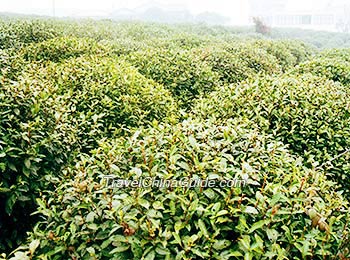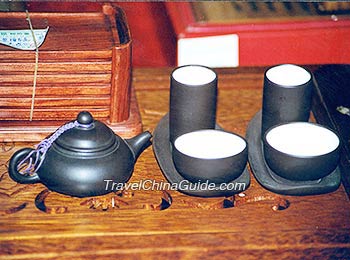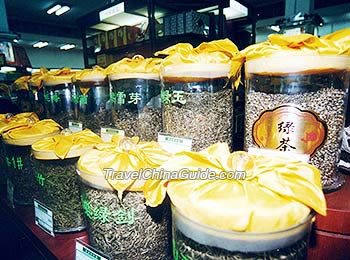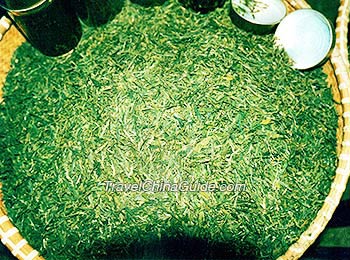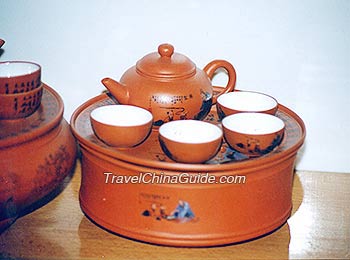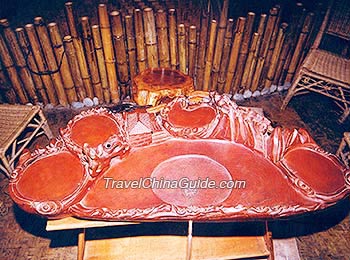Chinese Tea
Tea was first discovered and drunk in China. As the hometown of tea, China owns a deep tea culture from ancient times. For Chinese people, it is not only a popular beverage which is brewed with boiled water over cured leaves, with a lot of health benefits. Moreover, it keeps a central piece of Chinese traditional culture, attaching great importance to spiritual enjoyment and ethics. Today, China still accounts for 60% of tea plantations in the world and a great number of tea gardens scatter in more than 20 provinces throughout the country.
Chinese tea can be classified in many ways, such as quality, producing area, growth environment and processing method. Here we talk about is the most common classification of Chinese tea: basic tea and reprocessing tea. The basic tea, mostly divided into 6 major types, is according to the degree of fermentation (oxidation) which is directly reflected in the color of tea. The reprocessing tea is the tea reprocessed from basic tea, which includes flower tea like jasmine tea, compressed tea, liquid tea, instant tea and herbal tea.
Green tea is the most famous Chinese tea with the longest history and it is unfermented. Famous green tea: Longjing, Huangshan Maofeng, Biluochun, Xinyang Maojian, Liu'an Melon Seed Tea…
 See more: 10 Best Chinese Green Tea
See more: 10 Best Chinese Green Tea
Also called red tea, black tea is a kind of fully fermentative tea which offers a strong flavor with dark brown tea soup color.
Famous black tea: Keemun Black Tea, Yunnan Black Tea…
Oolong tea is half-fermented, combing the light fragrance of green tea and mellow flavor of black tea and it is also named blue tea. Famous oolong tea: Anxi Tieguanyin, Wuyi Tea…
 See more: 10 Amazing Benefits of Oolong Tea
See more: 10 Amazing Benefits of Oolong Tea
White tea is the lightly fermented tea processed from young buds of tea leaves. Named so because it is covered by the fine white fuzz.
Famous white tea: Baihao Yinzhen, Baimudan, Gongmei…
The process method of yellow tea is similar to that of green tea. Just add a key step of heaping tea leaves for yellowing. Famous yellow tea: Mengding Huangya, Junshan Yinzhen…
After long-time fermentation, the color of tea leaves will become dark. This kind of post-fermented tea is dark tea, mainly used to make tea bricks.
Famous dark tea: Pu Erh, Guangxi Liubao…
 See more:
See more:
10 Best Chinese Tea
4 Most Famous Chinese Chrysanthemum Tea
9 Most Popular Chinese Flower Tea
8 Chinese Herbal Tea You can Have a Try
Chinese people are believed to have enjoyed tea drinking for more than 4,000 years. Legend has it that Yan Emperor Shennong, one of three rulers in ancient times, tasted all kinds of herbs to find medical cures. One day, as he was being poisoned by some herb he had ingested; a drop of water from a tea tree dripped into his mouth and he was saved. This was how tea was discovered.
For a long time, tea was used as herbal medicine. During the Western Zhou Dynasty (1046 BC - 771 BC), it was a religious offering. The earliest record about tea as a drink appeared in the Western Han Dynasty (202 BC - 9), which indicates the actual time may be earlier than that. Chinese tea culture prospered during the Tang Dynasty (618 - 907) because of a famous person, Lu Yu, Tea Sage of China. The Tea Classics wrote by him is a tea encyclopedia, detailing rules concerning various aspects of tea, such as growth areas for tea trees, wares and skills for processing and tasting of tea, and the history of Chinese tea. Also, in this period, tea seeds were taken to Japan but the tea culture didn’t spread in Japan until the South Song Dynasty (1127 - 1279). In the Song Dynasty, Arabic merchants exported tea from Quanzhou, Fujian Province. Tea was sold to Southeast Asian and South African countries in the Ming Dynasty (1368 - 1644). In 1610, it went to Europe via Macau in a Dutch merchant ship. Thus it became an international drink.
According to scientific research, there are more than 450 kinds of beneficial chemical components in the tea, such as chlorophyll, vitamins, lipids, caffeine, and tea polyphenols. Multiple benefits can be brought through drinking different types of Chinese tea. Below are the widely recognized health benefits of Chinese tea:
1. Lose Weight
Green tea, Oolong tea and dark tea are effective in losing weight. Especially green tea, with a variety of vitamins and contains the key health benefit element, catechuic.
 See more:
See more:
8 Weight Loss Tea You can Have a Try
12 Diet Tea that Makes You Slim and Fit
2. Lower Risk of Cardiovascular Disease
Tea polyphenols are helpful in reducing hypertension and cholesterol to lower the risk of Cardiovascular Disease. What’s more, the theaflavin in black tea, is the most important functional component and has a better effect in preventing cardiovascular disease, very proper for the elderly.
3. Prevent Bone Loss
The study found that people who drank more tea had higher bone density while tea drinkers have a lower risk of hip fractures. Green tea is especially a helper to improve bone density.
4. Anti-Radiation
Green tea and white tea have a better anti-bacterial anti-radiation effect compared with other tea. Some components of white tea have been used in the development of facial skin care products in the United States and Europe.
 See more: 7 Wonderful Benefits of Chinese Tea
See more: 7 Wonderful Benefits of Chinese Tea
Chinese tea ceremony consists of tea making and drinking. Besides the making process and drinking enjoyment, it is more about the way Chinese people interact with tea. The delicate tea set, quality water, elegant way of brewing, and graceful atmosphere all constitute the core of the Chinese tea ceremony.
Tea ceremony flourishes in Japan, but it is originated in China. Making tea, smelling tea and appreciating tea, the ceremony is fused the philosophy of Taoism, Confucian and Buddhism, making people explore their spiritual world and offering refreshments.
 See more:
See more:
Tea Culture
How to Make Chinese Tea - 7 Steps 1. Observe. Good or fresh tea has a green luster in a tight shape, but a poor one is loose and dull. The leaves should be dry enough to make a rustling noise in the palm.
2. Smell. The fragrance should be pure without a charred taste or acid smell. Good tea, especially fresh one, has a natural aroma like orchid or jasmine while the poor one smells stale.
3. Taste. You can taste the leaves by chewing them carefully. Good tea leaves have a fresh mellowness. You can also infuse some to see if the leaves extend smoothly and sink slowly to the bottom. Good tea liquor is emerald green or golden. It has a tint of bitterness with a lasting sweet aftertaste. Stale liquor is malodorous and dark brown.
4. See the infused tea leaves. The infused leaves should be even without impurity.
After you purchase good tea, keep it in a dry cool place, avoiding direct sunshine. An airtight container is a good choice. Avoid putting teas of different aromas too close.
Further Reading:
Top 10 Most Expensive Tea in China
Top 10 Most Beautiful Tea Gardens in China
Yum Cha – Cantonese Tea Brunch Tradition
|
|
Chinese Tea Types
|
|
Also called red tea, black tea is a kind of fully fermentative tea which offers a strong flavor with dark brown tea soup color.
Famous black tea: Keemun Black Tea, Yunnan Black Tea…
Oolong tea is half-fermented, combing the light fragrance of green tea and mellow flavor of black tea and it is also named blue tea. Famous oolong tea: Anxi Tieguanyin, Wuyi Tea…
White tea is the lightly fermented tea processed from young buds of tea leaves. Named so because it is covered by the fine white fuzz.
Famous white tea: Baihao Yinzhen, Baimudan, Gongmei…
Yellow Tea
Dark Tea
Famous dark tea: Pu Erh, Guangxi Liubao…
10 Best Chinese Tea
4 Most Famous Chinese Chrysanthemum Tea
9 Most Popular Chinese Flower Tea
8 Chinese Herbal Tea You can Have a Try
Chinese Tea History
For a long time, tea was used as herbal medicine. During the Western Zhou Dynasty (1046 BC - 771 BC), it was a religious offering. The earliest record about tea as a drink appeared in the Western Han Dynasty (202 BC - 9), which indicates the actual time may be earlier than that. Chinese tea culture prospered during the Tang Dynasty (618 - 907) because of a famous person, Lu Yu, Tea Sage of China. The Tea Classics wrote by him is a tea encyclopedia, detailing rules concerning various aspects of tea, such as growth areas for tea trees, wares and skills for processing and tasting of tea, and the history of Chinese tea. Also, in this period, tea seeds were taken to Japan but the tea culture didn’t spread in Japan until the South Song Dynasty (1127 - 1279). In the Song Dynasty, Arabic merchants exported tea from Quanzhou, Fujian Province. Tea was sold to Southeast Asian and South African countries in the Ming Dynasty (1368 - 1644). In 1610, it went to Europe via Macau in a Dutch merchant ship. Thus it became an international drink.
|
|
Health Benefits of Chinese Tea
1. Lose Weight
Green tea, Oolong tea and dark tea are effective in losing weight. Especially green tea, with a variety of vitamins and contains the key health benefit element, catechuic.
8 Weight Loss Tea You can Have a Try
12 Diet Tea that Makes You Slim and Fit
2. Lower Risk of Cardiovascular Disease
Tea polyphenols are helpful in reducing hypertension and cholesterol to lower the risk of Cardiovascular Disease. What’s more, the theaflavin in black tea, is the most important functional component and has a better effect in preventing cardiovascular disease, very proper for the elderly.
3. Prevent Bone Loss
The study found that people who drank more tea had higher bone density while tea drinkers have a lower risk of hip fractures. Green tea is especially a helper to improve bone density.
4. Anti-Radiation
Green tea and white tea have a better anti-bacterial anti-radiation effect compared with other tea. Some components of white tea have been used in the development of facial skin care products in the United States and Europe.
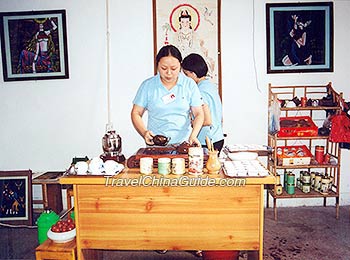 |
| Tea Ceremony |
Tea ceremony flourishes in Japan, but it is originated in China. Making tea, smelling tea and appreciating tea, the ceremony is fused the philosophy of Taoism, Confucian and Buddhism, making people explore their spiritual world and offering refreshments.
Tea Culture
How to Make Chinese Tea - 7 Steps
4 Steps to Select Chinese Tea
2. Smell. The fragrance should be pure without a charred taste or acid smell. Good tea, especially fresh one, has a natural aroma like orchid or jasmine while the poor one smells stale.
3. Taste. You can taste the leaves by chewing them carefully. Good tea leaves have a fresh mellowness. You can also infuse some to see if the leaves extend smoothly and sink slowly to the bottom. Good tea liquor is emerald green or golden. It has a tint of bitterness with a lasting sweet aftertaste. Stale liquor is malodorous and dark brown.
4. See the infused tea leaves. The infused leaves should be even without impurity.
How to Store Chinese Tea
Further Reading:
Top 10 Most Expensive Tea in China
Top 10 Most Beautiful Tea Gardens in China
Yum Cha – Cantonese Tea Brunch Tradition
- Last updated on Aug. 09, 2022 -
Questions & Answers on Chinese Tea
Asked by nyasia from NORTH CAROLINA | Feb. 18, 2016 09:46 Reply
Reply
how does tea drop blood pressure??
i heard that tea can drop blood sure but i dont understand how its just a drink so if tea can drop blood pressure why cant other drinks because thats what tea is a drin someone help me understand
thank you
thank you
Answers (1)
Answered by Mickey from RUSSIA | Feb. 18, 2016 20:28 3
3 14
14 Reply
Reply
According to my searching, the tea pigment can prevent the blood from being viscous. This will help decrease the blood pressure in some degree. It is really a healthy food.
